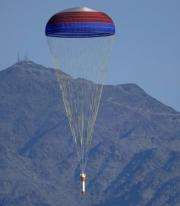Ares Super-chute

NASA and U.S. Air Force test pilots have just dropped a 50,000-pound "dummy" rocket booster on the Arizona desert--and stopped it before it crashed. It's all part of NASA's plan to return to the Moon.
"NASA's new Ares moon rocket is going to have a reusable booster stage that we plan to recover after each mission," explains James Burnum of Marshall Space Flight Center. "To 'catch' the booster before it crashes back to Earth, we need a super-reliable parachute system."
Chief pilot Frank Batteas of Dryden Flight Research Center helped a NASA-led team test one of the super-chutes on Feb. 28th, and he offers this account:
"We flew at 175 knots at 25,000 feet, and dropped one of the heaviest payloads a C-17 has ever carried - a 50,000 pound stand-in for the spent Ares booster," says Batteas. "A lot of things have to happen correctly for such a test to be successful. A great deal of teamwork, among NASA, the Air Force, the Army, Boeing, and others, goes into planning and executing events both inside and outside the plane."
Burnum adds, "not only is planning critical, but also the aircraft pilot's skill and experience are paramount. The Air Force saw to it that we were placed in very good hands. Batteas was one of the very first test pilots for the C-17 and has flown this aircraft for about 1000 of its 3000 total hours, so he knows the plane like the back of his hand. This kind of excellent support from the Air Force lets us concentrate on our hardware. We don't worry at all about the plane or piloting."
The Ares booster recovery parachute system consists of (1) a small pilot chute, which pulls out the drogue chute; (2) a drogue chute, and (3) three main parachutes. All three components are being subjected to testing.
In the recent test, the 68-foot diameter drogue parachute got a chance to prove itself. Its ultimate job will be to slow the Ares I rocket's jettisoned booster and orient it vertically before the cluster of three main parachutes deploys to carry the booster to splashdown.
The drogue chute passed its test with flying colors. It slowed the descent of its ungainly passenger - a 50,000-pound steel, missile shaped test payload - sufficiently for the main parachute to deliver it to good old terra firma in Yuma, Arizona for recovery. Like the booster, the test payload will be reused.
"The steel 'missile' used for testing has cavities for adjusting the weight of the payload," says Franz Ravelo, C-17 Mission Systems Engineer at the Air Force Flight Test Center in Edwards Air Force Base, California. "We'll reuse it for future Ares parachute testing with 70,000, 77,000, 85,000, and finally 90,000 pound payloads."
The Feb. 28th drop went off entirely without a hitch - well, almost.
"The day testing was scheduled for, 80 mph winds were blustering at 25,000 ft, causing a slip in the schedule," says Batteas. "We ended up testing on my birthday, so I missed the celebration they held for me back at Dryden," says Batteas. "They did call me and sing 'Happy Birthday' to me over the phone. And my wife saved me some cake."
He didn't really mind working that day, though.
"When you see that mammoth payload plunge Earthward and then slow as the chutes deploy, it is very satisfying. It's exciting to see it really work. And with each test there are many lessons learned which make it safer for the next test--and take us that much closer to the Moon."
Source: Science@NASA, Dauna Coulter



















